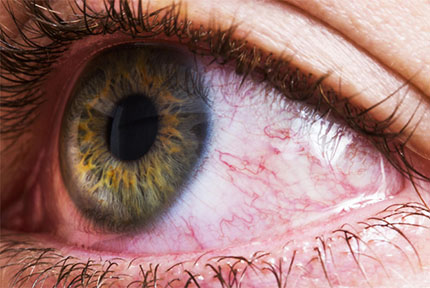Treatment of Painful or Red Eyes
“Red Eye” is the term used to describe red, irritated and bloodshot eyes. Red eyes occur when the blood vessels on the surface of the eye expand. The appearance of red eye ranges in severity from a bright red that completely covers the sclera to a few enlarged blood vessels that look like wiggly red or pink lines across the "white" of the eye. Red eyes usually are caused by allergy, eye fatigue, over-wearing contact lenses or common eye infections such as pink eye (conjunctivitis).

However, redness of the eye sometimes can signal a more serious eye condition or disease, such as uveitis or glaucoma. If your red eye persists or worsens, always contact your eye doctor for proper diagnosis and treatment.
Red eyes while wearing contacts could be a sign of a serious eye infection, such as keratitis or fungal eye infections. If your eyes become red while wearing contact lenses, remove your contacts immediately and visit your eye doctor.
Red Eye may also be associated with the following eye disease:
- Blepharitis
- Cellulitis
- Conjunctivitis (Pink Eye)
- Corneal Abrasion
- Corneal Ulcer
- Eye Allergies
- Fungal Keratitis
- Glaucoma
- Herpes Keratitis
- Pinguecula and Pterygium
- Retinoblastoma
- Subconjunctival Hemorrhage
It's important to remember that many people do not know they have eye disease because there are often no warning signs or symptoms, or they assume that poor sight is a natural part of growing older. Early detection and treatment of eye problems is the best way to keep your healthy vision throughout your life. In many cases, blindness and vision loss are preventable.
Most patients have improved vision the day after their procedure, with vision continuing to improve over the following days to weeks.
In order to prevent red eyes, follow these helpful tips:
- Don't rub your eyes
- Practice good hygiene when wearing contact lenses.
- Speak to your doctor about allergy medications to help keep allergies at bay.
- Take a break from looking at the computer screen and follow the 20-20-20 rule: look away from your computer every 20 minutes and gaze at a distant object 20 feet away for at least 20 seconds.
- Schedule an eye exam
- Don't over-use "whitening" eye drops

